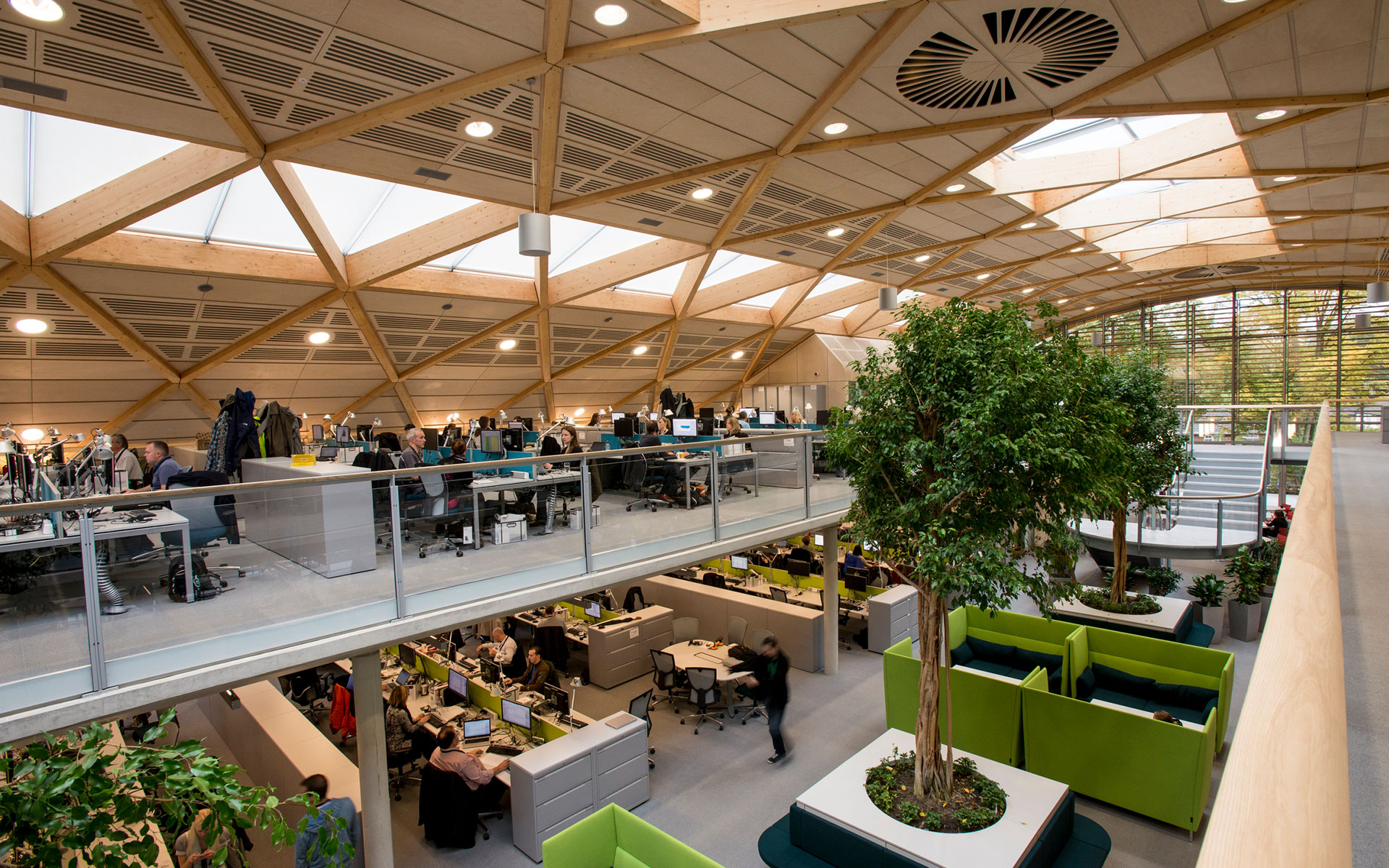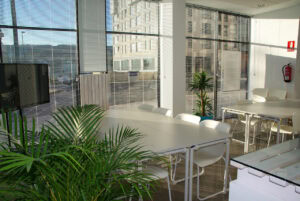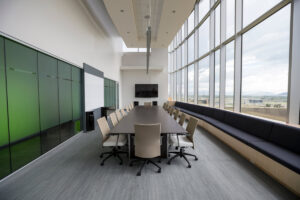Space utilisation: Optimising space, boosting productivity, and keeping in budget

Hybrid working is now standard, making it imperative for companies to reconsider the spaces they are utilising – as well as the ones they are not. Despite this, Resume Builder reports that 90% of businesses plan to have most of their staff back in the workplace by the end of 2024. Therefore it is crucial to optimise office space, enhance productivity, and avoid unnecessary expenses. In this guide, we will discuss effective ways to utilise office space and ensure that you get the most out of it while keeping costs low.
THE DEFINITION OF SPACE UTILISATION HAS CHANGED
Space utilisation is crucial, especially since remote working has altered its definition. Previously, space utilisation was calculated by dividing the number of employees by the available desk space. However, with the rise of hybrid working, the traditional office setup is becoming obsolete. Some offices still have a desk for each employee, while others have adopted the hot-desk system. Moreover, most staff now choose the days they come into the office, making it imperative to consider office functionality, patterns, and employee attendance frequencies.

As definitions of space utilisation continue to change, the functions of the office also follow suit. The workplace used to be a space for employees to sit and work, but now it has become more dynamic, functioning as a social hub for staff or a centre for collaboration and training. Therefore, it’s crucial to determine early on what you aim to achieve to help shape any space optimisation plans.
”Concentration was previously on staff retention because suddenly employees were in control due to the thousands of unfilled vacancies. Flexible working was a common demand in interviews, and businesses had to accommodate. That’s flipped around now, and businesses have more control. Businesses need to strike a balance by ensuring the workplace is a place where their staff feel motivated and comfortable, where sustainability and well-being are top of the agenda.”
Ashley Lawrence, Head of Interiors at Crown Workspace UK, discusses this ongoing shifting focus.

CREATING AN ENVIRONMENT THAT EMPLOYEES WANT TO BE IN
Companies are likely to face a significant challenge in motivating their employees to return to the office. Hybrid working has provided employees with numerous benefits, including a better work-life balance, eliminating commuting time, and saving money on transportation.
Well-organised office space can boost productivity and efficiency. Collaboration areas make teamwork easier, while attractive communal areas can be positive for any training or workshops taking place on-site. To make the most of limited office space, consider establishing areas that serve multiple purposes. Create communal areas where staff can unwind, but where teams can also gather for more informal meetings. Finding duality can be particularly effective for businesses with limited office space.
Ashley suggests that businesses should aim to ‘bring the best parts of the home office into the workplace.’ However, every office has different needs. Conduct a staff survey to identify what staff want to see. Use the survey results to ensure that you are looking after everyone in your workforce, outlining what will make them want to come to work.
IS YOUR OFFICE SUITABLE?
It is important to consider if the space will work for the business not just now, but also in the future. An office is the centre of any business, so it is crucial to determine if it will suit current and future plans.
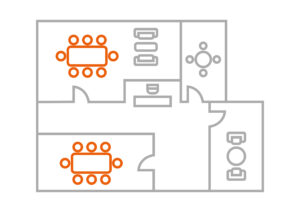
Heat mapping can be used to identify the most commonly used areas in the office, as well as the areas that remain empty most of the time. Identify the areas that staff use the most and retrieve data from a cross-section of employees to get a more holistic view. Consulting with the workforce can also help identify any current and future projects and determine if the current office setup can accommodate them.
For the first half of 2024, people will remain cautious about returning to the office, particularly due to the costs this will involve. Yet, the second half of the year will deliver the return to the office, so managers must prepared. ~ Ahsley Lawrence, Head of Interiors at Crown Workspace UK
Evaluating current office space will help make more informed decisions in the long run. Opting for smaller desk spaces or a hot-desk system can help free up space, while reservation systems can ensure the effective use of areas in high demand and encourage future planning among staff.
SPACE OPTIMISATION THAT DOESN’T BREAK THE BANK
Implementing changes can initially seem expensive, but it doesn’t have to be. There are several cost-effective solutions available that can also reduce waste.
Identifying underutilised areas can help determine where budgets should be focused. There is no reason to keep an area of the office that is not being used, so it’s important to find ways to repurpose these areas for other functions. For example, a conference room could also serve as a training room. Additionally, popular areas of the office may require attention to reduce crowding, which can be achieved through regular maintenance and shared amenities. Modular furniture is an excellent investment as it offers flexibility and versatility that can contribute to cost-cutting practices.
Modular furniture, including seating, shelves, and storage, can be reconfigured to adapt to a developing office space, ensuring a longer lifespan for these pieces and avoiding the need for future furniture purchases. They can also reduce the need to invest in separate areas, thus allowing for less furniture in the workplace. For instance, modular desks with adjustable heights and reconfiguration options can double as a workstation or collaboration table, saving both expenditure and space.
When purchasing equipment, consider recycled or upcycled pieces for both affordability and sustainability. Refurbished furniture is a great option that looks unused, comes with a warranty, and saves massively on embodied carbon for a significantly smaller cost and on a shorter lead time.
If space is being repurposed and/or there is a plan to retain an element of hybrid working, introducing a timetable or regular schedule that outlines when teams are expected to come to the office can help encourage office attendance while providing the option to reduce desk count, decrease office space, and save money.
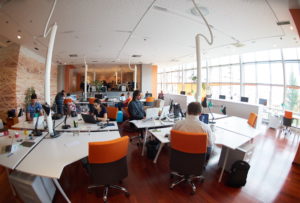
SUMMARY
The effective use of space can significantly impact an organisation. In light of the shift to hybrid working patterns, businesses must proactively rethink the suitability of their current space. To avoid any negative impact on employees, businesses must ensure that the office is a place where staff want to be.
Therefore, conducting a space utilisation survey that includes heat mapping and staff feedback is essential to identify underutilised or high-demand areas and raise awareness of any requirements from staff. Modular furniture and its adaptability are crucial in space utilisation, allowing spaces to be reconfigured for multiple uses. Businesses must make appropriate adjustments and integrations to boost productivity among staff and control costs through space management and a reduction in furniture items. It is non-negotiable that businesses prioritise the effective use of space to ensure a positive impact on staff and the organisation as a whole.
Related stories
Walk into modern offices and you’ll see the motifs of sustainability: a living wall in reception, branded reusable mugs in the pantry, perhaps even a rooftop beehive. These are the sort of things that photograph well and tick boxes in annual reports. But what truly makes an office “green”? The uncomfortable truth is that many […]
Sustainability is everywhere in workplace design. From rooftop gardens to recycled coffee cups, offices are quick to showcase their “green” credentials. But how much of this activity delivers genuine environmental impact, and how much is simply optics?
Let’s start with the conclusion: The honest answer is that both stories are true. Some organizations are taking up more and larger offices, others are compressing. What ties the two together is a single idea that now sits at the heart of Facilities Management: rightsizing. Size follows purpose. If the purpose is clearer collaboration, better […]

























